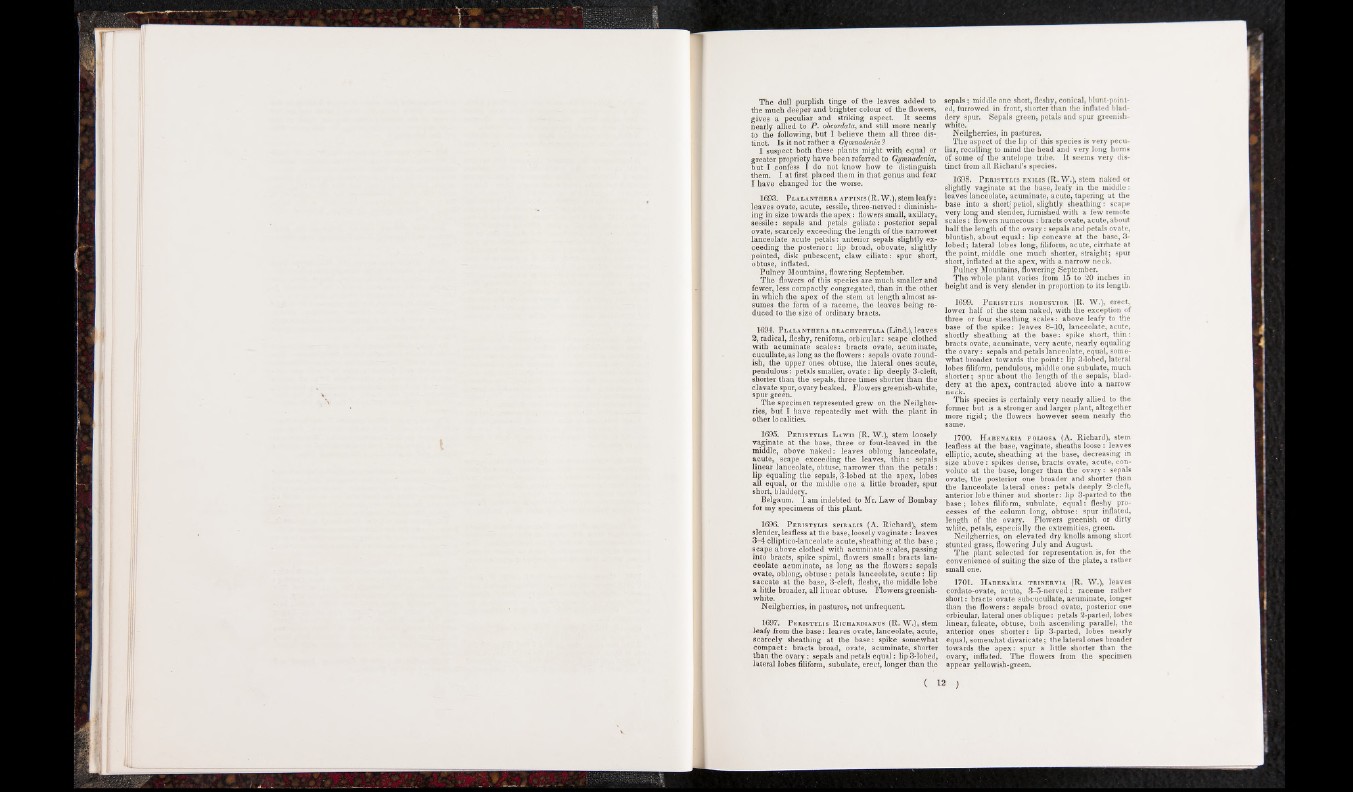
The dull purplish tinge of the leaves added to
the much deeper and brighter colour of the flowers,
gives a peculiar and striking aspect. It seems
nearly allied to P . obcordata, and still more nearly
to the following, but I believe them all three distinct.
Is it not rather a Gymnadenia ?
I suspect both these plants might with, equal or
greater propriety have been referred to Gymnadenia,
but I „confess I do not know how to distinguish
them. I at first placed them in that genus and fear
I have changed for the worse.
1693. Plalanthera affinis (R. W.), stem leafy:
leaves ovate, acute, sessile, three-nerved: diminishing
in size towards the apex: flowers small, axillary,
sessile: sepals and petals galiate: posterior sepal
ovate, scarcely exceeding the length of the narrower
lanceolate acute petals: anterior sepals slightly exceeding
the posterior: lip broad, obovate, slightly
pointed, disk pubescent, claw ciliate: spur short,
obtuse, inflated.
Pulney Mountains, flowering September.
The flowers of this species are much smaller and
fewer, less compactly congregated, than in the other
in which the apex of the stem at length almost assumes
the form of a raceme, the leaves being reduced
to the size of ordinary bracts.
1694. Plalanthera brachyphylla (Lind.), leaves
2 ,radical, fleshy, reniform, orbicular: scape clothed
with acuminate scales: bracts ovate, acuminate,
cucullate, as long as the flowers: sepals ovate roundish,
the upper ones obtuse, the lateral ones acute,
pendulous: petals smaller, ovate: lip deeply 3-cleft,
shorter than the sepals, three times shorter than the
clavate spur, ovary beaked. Flowers greenish-white,
spur green.
The specimen represented grew on the Neilgher-
ries, but I have repeatedly met with the plant in
other localities.
1695. Peristylis Lawii (R. W.), stem loosely
vaginate at the base, three or four-leaved in the
middle, above naked: leaves oblong lanceolate,
acute, scape exceeding the leaves, th in : sepals
linear lanceolate, obtuse, narrower than the petals:
lip equaling the sepals, 3-lobed at the apex, lobes
all equal, or the middle one a little broader, spur
short, bladdery.
Belgaum. I am indebted to Mr. Law of Bombay
for my specimens of this plant.
1696. Peristylis spiralis (A. Richard), stem
slender, leafless at the base, loosely vaginate: leaves
3-4 elliptico-lanceolate acute, sheathing at the base ;
scape above clothed with acuminate scales, passing
into bracts, spike spiral, flowers small: bracts lanceolate
acuminate, as long as the flowers: sepals
ovate, oblong, obtuse: petals lanceolate,' a c u te : lip
saccate at the base, 3-cleft, fleshy, the middle lobe
a little broader, all linear obtuse. Flowers greenish-
white.
Neilgherries, in pastures, not unfrequent.
1697. Peristylis Richardianus (R. W.), stem
leafy from the base: leaves ovate, lanceolate, acute,
scarcely sheathing at the base: spike somewhat
compact: bracts broad, ovate, acuminate, shorter
than the ovary: sepals and petals equal: lip 3-lobed,
lateral lobes filiform, subulate, erect, longer than the
sepals; middle one short, fleshy, conical, blunt-pointed,
furrowed in front, shorter than the inflated bladdery
spur. Sepals green, petals and spur greenish-
white.
Neilgherries, in pastures.
The aspect of the lip of this species is very peculiar,
recalling to mind the bead and very long horns
of some of the antelope tribe. It seems very distinct
from all Richard’s species.
1698. Peristylis exilis (R. W.), stem naked or
slightly vaginate at the base, leafy in the middle:
leaves lanceolate, acuminate, acute, tapering at the
base into a short] petiol, slightly sheathing: scape
very long and slender, furnished with a few remote
scales: flowers numerous: bracts ovate, acute, about
half the length of the ovary: sepals and petals ovate,
bluntish, about equal: lip concave at the base, 3-
lobed; lateral lobes long, filiform, acute, cirrhate at
the point, middle one much shorter, straight; spur
short, inflated at the apex, with a narrow neck.
Pulney Mountains, flowering September.
The whole plant varies from 15 to 20 inches in
height and is very slender in proportion to its length.
1699. Peristylis robustior (R. W.), erect,
lower half of the stem naked, with the exception of
• three or four sheathing scales: above leafy to the
base of the spike: leaves 8-10, lanceolate, acute,
shortly sheathing at the base: spike short, th in :
bracts ovate, acuminate, very acute, nearly equaling
the ovary: sepals and petals lanceolate, equal, somewhat
broader towards the point: lip 3-lobed, lateral
lobes filiform, pendulous, middle one subulate, much
shorter; spur about the length of the sepals, bladdery
at the apex, contracted above into a narrow
neck.
This species is certainly very nearly allied to the
former but is a stronger and larger plant, altogether
more rigid; the flowers however seem nearly the
same.
1700. Habenaria foliosa (A. Richard), stem
leafless at the base, vaginate, sheaths loose: leaves
elliptic, acute, sheathing at the base, decreasing in
size above: spikes dense, bracts ovate, acute, convolute
at the base, longer than the ovary: sepals
ovate, the posterior one broader and shorter than
the lanceolate lateral ones: petals deeply 2-cleft,
anterior lobe thiner and shorter: lip 3-parted to the
b a se ; lobes filiform, subulate, equal: fleshy processes
of the column long, obtuse: spur inflated,
length of the ovary. Flowers greenish or dirty
white, petals, especially the extremities, green.
Neilgherries, on elevated dry knolls among short
stunted grass, flowering July and August.
The plant selected for representation is, for the
convenience of suiting the size of the plate, a rather
small one.
1701. Habenaria trinervia (R. W.), leaves
cordato-ovate, acute, 3-5-nerved: raceme rather
short: bracts ovate subcucullate, acuminate, longer
than the flowers: sepals broad ovate, posterior one
orbicular, lateral ones oblique: petals 2-parted, lobes
linear, falcate, obtuse, both ascending parallel, the
anterior ones shorter: lip 3-parted, lobes nearly
equal, somewhat divaricate; the lateral ones broader
towards the apex: spur a little shorter than the
ovary, inflated. The flowers from the specimen
appear yellowish-green.